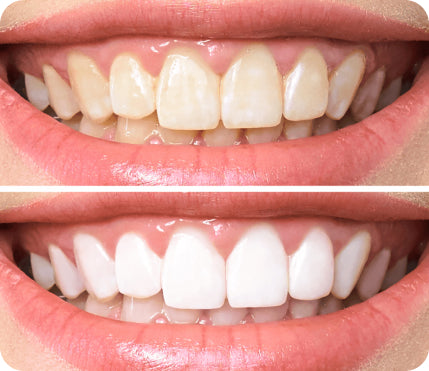
All products are certified by dental expert Dr. Greg Grillo
In the event of tooth loss or the need for a replacement, dental bridges are one option patients have. Maryland bridges, although uncommon, are one type of bridge. This article will discuss the cost, procedure, benefits, and uses of Maryland dental bridges so that patients can better understand this particular option.
Tooth loss or removal can happen for numerous reasons:
- Trauma or injury to the face that results in a broken or knocked-out tooth
- Decay and cavities that weaken teeth to the point that they fall out
- Periodontal disease that leads to bone loss around the teeth
- Orthodontic treatments that involve the removal of teeth
- Genetic factors such as cleft palate or missing teeth
If one or more of these factors exists, patients will need to have a replacement tooth (or teeth) put in.
For some, a Maryland bridge is one available option.
In this article, we'll give you everything you need to know about Maryland bridges to help you determine if this is the right tooth replacement for you.
What Is A Maryland Bridge?
A Maryland bridge—also known as a resin-bonded bridge—is a type of dental bridge that replaces a missing tooth. Unlike traditional bridges supported by dental crowns or implants, Maryland bridges rely on a framework of metal or porcelain bonded to the back of adjacent teeth with a special resin adhesive.
This type of dental bridge is typically used to replace missing front teeth. It can be an excellent option for patients who want a less invasive and more affordable alternative to dental implants or traditional bridges. As such, the Maryland bridge is sometimes preferred by patients with minimal tooth damage or who want a quicker and less painful solution for their missing teeth.
Maryland bridges are much less common now, as they require more maintenance than other types of bridges and are less reliable over the long term.
How Do Maryland Bridges Work?
Maryland bridges consist of metal or porcelain “wings” that bond to the back of adjacent teeth with a resin made of acrylic, composite, or metal. This framework holds the prosthetic tooth in place and creates a seamless smile by hiding all of the hardware from view.
The prosthetic tooth is made of a material that is designed to mimic the look and feel of natural teeth, such as porcelain or ceramic. This material is carefully color-matched to the surrounding teeth, ensuring that the Maryland bridge blends seamlessly with the rest of the patient's smile.
Maryland Bridge Procedure
The Maryland bridge procedure can typically be completed in two visits to the dental office, and patients can expect the following steps:
Step 1: Consultation And Planning
The first step is to consult a dental professional to determine if a Maryland bridge is the right option for the patient's needs.
If the dentist and patient decide that a Maryland bridge is the best solution, the dentist will develop a customized treatment plan based on the patient's specific needs and preferences.
Step 2: Preparation Of Adjacent Teeth
Unlike traditional bridges, which require the adjacent teeth to be shaved down to accommodate dental crowns, Maryland bridges only require a small amount of enamel to be removed from the back of the adjacent teeth.
This is done to ensure a secure bond between the Maryland bridge and the adjacent teeth.
When the dentist prepares the teeth, they will also give the patient a removable dental bridge (if the situation allows it). That way, the patient won't have to worry about the aesthetic of their teeth while they wait for the more permanent bridge.
Step 3: Impressions And Customization
Once the teeth are prepared, the dentist will take impressions of the area, which are sent to a dental laboratory where the Maryland bridge is custom-made.
During this step, the prosthetic tooth is carefully crafted to match the color, shape, and size of the patient's natural teeth, ensuring a seamless and natural-looking smile.
Step 4: Bonding
When the Maryland bridge is ready, the patient will return to the dental office for the final step of the procedure. The dentist will bond the Maryland bridge to the back of the adjacent teeth using a special resin adhesive.
This process is quick and painless. And once complete, the patient will have a fully restored smile.
Maryland Bridges Vs. Regular Bridges
While Maryland bridges and regular bridges share the same objective of replacing a missing tooth, there are some key differences between the two.
-
Invasiveness of the procedure: Regular bridges—including cantilever bridges and other implant-supported options—require the adjacent teeth to be shaved down and fitted with dental crowns to hold the bridge in place securely. This can be a more invasive procedure than Maryland bridging, which only requires a small amount of enamel removed from the back of the adjacent teeth.
-
Maintenance: Regular bridges often require less maintenance than—are supported by dental crowns or implants attached to the adjacent teeth. This requires a more invasive procedure, as the adjacent teeth must be shaved down to accommodate the dental crowns or implants. The prosthetic tooth is attached to these crowns or implants, creating a stable and long-lasting solution for missing teeth.
-
Support provided: Regular bridges offer a high level of stability and support. Maryland bridges, on the other hand, rely on adjacent teeth to hold the prosthetic tooth in place. While this can be an effective solution for individuals with strong neighboring teeth and excellent oral hygiene, it may not be suitable for all patients.
- Maintenance: Regular bridges require less maintenance than Maryland bridges, as dental crowns or implants hold them firmly in place. Maryland bridges usually work fine but may require more regular adjustment, as the resin used to bond the bridge can weaken over time.
In short, Maryland bridges offer a conservative alternative to traditional bridges for people who want to replace a missing tooth without invasive procedures or the need for dental implants. Since metal wings fit behind the abutment teeth, no shaving or reshaping is necessary, making the process less invasive and time-consuming.
Advantages Of Maryland Dental Bridge
Maryland bridges offer several advantages over traditional tooth replacement options. Here are some of the key advantages of Maryland bridges:
-
Non-invasive procedure: One of the biggest advantages of Maryland bridges is that it is a non-invasive procedure. Unlike traditional bridges, which require the adjacent teeth to be shaved down to accommodate dental crowns, Maryland bridges only require a small amount of enamel to be removed from the back of the adjacent teeth. This means that the procedure is less invasive and carries fewer risks.
-
Seamless smile: Maryland bridges are designed to blend seamlessly with the surrounding teeth, providing patients with a natural-looking and aesthetically pleasing smile. The prosthetic tooth is carefully color-matched to the surrounding teeth, ensuring that the bridge is virtually indistinguishable from the rest of the patient's teeth.
-
Minimal tooth preparation: In comparison to full-coverage crowns, Maryland bridges involve a significantly less amount of preparation. They require only the removal of about half the coronal tooth structure, making the procedure much quicker and easier. This also means that the procedure is less damaging to the adjacent teeth, and the patient experiences less discomfort.
- Easy to clean: Maryland bridges are easy to clean and maintain, as they do not disturb the surrounding teeth. Patients can still brush their teeth easily and effectively, ensuring good oral hygiene and preventing future dental problems.
Disadvantages Of Maryland Dental Bridge
For most, the cons outweigh the pros when it comes to Maryland bridges. Disadvantages of Maryland bridges include:
-
Potential for damage to adjacent teeth: Maryland bridges rely on adjacent teeth for support, and bonding the bridge to the back of the teeth can potentially cause damage to healthy teeth. Over time, the metal or porcelain framework may cause erosion or decay to the teeth supporting the bridge, leading to further dental issues.
-
Limited durability: Maryland bridges are less durable or long-lasting than traditional ones. Because they rely on bonding to the adjacent teeth, they may be more prone to chipping or breaking and cannot withstand the pressure of chewing as well as other bridge types.
-
Limited applicability: Maryland bridges are not suitable for all patients, as they require strong and healthy adjacent teeth to support the bridge. Patients with weaker teeth may not be good candidates for Maryland bridges.
- May require replacement: Maryland bridges may need to be replaced over time, as they may not provide the same level of stability or longevity as traditional bridges.
Although research shows a 95.1% success rate and a lifespan of 12 to 21 years, Maryland bridges aren't the best option—or the most cost-effective.
Patients should carefully evaluate the benefits of Maryland bridges vs. other tooth repair procedures before deciding.
Maryland Dental Bridge: Before And After (images)
Maryland Dental Bridge Aftercare
Once the bridgework is complete, proper aftercare is critical to ensure its longevity and effectiveness.
Here are some key tips for taking care of your Maryland bridge:
-
Brush and floss daily. Maintaining your oral health is important for the long-term success of your bridge. Brush twice daily and floss once per day to remove food particles and bacteria from between the teeth and under the bridge.
-
Attend regular dental checkups. Make sure to attend routine dental appointments for professional cleanings, examinations, and x-rays as your dentist advises. This will help ensure the bridge is in good condition and enable your dentist to detect any dental issues early.
-
Avoid hard, sticky food. Especially since Maryland bridges are less stable than other methods, it’s important to avoid foods and drinks that damage teeth—especially hard or sticky ones.
- If you grind your teeth or clench your jaw, fix it. Teeth grinding and clenching (bruxism) can cause your bridge to break much earlier than expected. Bruxism is a medical condition that requires therapy.
Maryland Dental Bridge Cost
Maryland dental bridges generally cost between $1,500 and $2,500.
The exact cost of the procedure depends on factors like the material used in the bridge, the number of teeth being replaced, the complexity of the case, and whether or not extra procedures are needed (such as root canal therapy).
In addition to the bridge itself, patients may need to pay for other costs associated with dental bridge treatment, such as x-rays, anesthesia, and the dentist’s fee.
Costs also vary based on the location of treatment. Major urban areas like Los Angeles, San Francisco, and New York will have higher fees than smaller cities and towns.
How Long Will A Maryland Dental Bridge Last?
A Maryland dental bridge typically lasts between 12 to 21 years, depending on how well it is cared for.
Good oral hygiene and regular dental appointments are key to ensuring the longevity of your bridge.
Tooth decay and bacterial growth can eat away at the structure of a bridge, so it’s important to monitor your bridge for signs of deterioration.
Want to learn more? Here are the questions our customers ask us the most.
Do Dentists Still Do Maryland Bridges?
Dentists will occasionally administer Maryland bridges if patients need just one or two front teeth replaced. They must also have excellent oral health, and their teeth must be strong enough to support the bridge.
Can You Eat After A Maryland Bridge?
After getting a dental bridge, it's wise to enjoy lukewarm or room-temperature foods that won't put too much pressure on the new bridge. To avoid any discomfort, try sticking with soft meals and drinks so as not to overburden your teeth.
After a few days, you can resume your normal eating habits, but remember that Maryland bridges are more susceptible to breakage.
How Many Teeth Can Be On A Maryland Bridge?
Maryland bridges can replace one or two missing teeth depending on the patient’s situation. If more than two teeth are missing, the patient would require either a traditional tooth bridge or dental implants.
What Can You Not Eat With A Maryland Dental Bridge?
With a Maryland dental bridge, it's best to avoid the following foods:
- Hard foods that require forceful bites on the bridge, such as apples, nuts, and carrots
- Sticky treats such as gummy bears and caramel
- Chewy foods like beef jerky and bubble gum
- Hot liquids and ice-cold drinks, which may cause sensitivity
- Sugary snacks that can result in tooth decay or cavities
What Is An Alternative To A Maryland Bridge?
There are several alternatives to Maryland bridges. Patients with part of the tooth remaining usually decide between tooth bridges and dental crowns. If the tooth is completely removed or broken, a dental implant is the alternative to a Maryland bridge.
Can A Maryland Bridge Be Removed?
Maryland bridges are removable—taking them out doesn't usually result in any further damage to the teeth. This makes them a preferred choice for people who don’t want to commit to a permanent solution or who plan on having additional treatments carried out on those teeth.
Can A Maryland Bridge Be Replaced?
Like all dental bridges, Maryland bridges can be replaced. In fact, they are one of the easiest kinds of dental bridges to replace because they are removable. All that's needed is to take the old bridge out and replace it with a new one, which can usually be done in a single visit to the dentist.
What Does A Maryland Dental Bridge Look Like?
A Maryland bridge looks like a standalone tooth with two bat wings or metal clasps behind it that attach to the adjacent teeth. The bridge itself is made of a porcelain material, making it indistinguishable from other healthy teeth.
Why Does My Maryland Bridge Keep Falling Out?
Maryland bridges are one of the least secure types of bridges, so it’s possible for them to slip out or become loose over time. Poor oral hygiene and eating hard foods can also break the bond between the bridge and the adjacent teeth, causing it to fall out. If your Maryland bridge keeps slipping out, visit your dentist as soon as possible to get it replaced.











